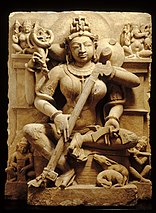The eka-tantrī vīṇā was a medieval tube-zither veena in India, with a single string and one or more gourd resonators. The instrument became prominent in Indian music in about the 10th century C.E. as instruments of court music. Alongside the alapini vina and kinnari vina it replaced the harp-style veenas and lute-style veenas in sculpture. It was possibly a forerunner of the rudra vina. It shares its name with the modern single-string drone lute, the ektara.
The instrument is very closely related to the one-stringed alapini vina, an instrument which started out a stick zither but became a tube zither like the eka-tantri vina.
Although the tube zithers and stick zithers are very similar, it is possible that they have different origins. Early paintings of stick zithers in India date back at least to the 5th century C.E. The earliest currently known stick zither is in the Caves of Ajanta at the end of the 5th century.[1] After a period of assuming that tube zithers spread from India to Southeast Asia, modern scholars have been trying to decide if the tube zithers might have originated in Southeast Asia and spread to India. Whatever the origins, Indian influence on musical culture in Southeast Asia is recorded in the archaeological remains of past civilizations.[2][3][4]
- ^ "The History". rudravina.com.
- ^ Alastair Dick; Gordon Geekie; Richard Widdess (1984). "Vina, section 4 Medieval stick zithers". In Sadie, Stanley (ed.). The New Grove Dictionary of Musical Instruments. pp. 729–730. Volume 3.
- ^ Piyal Bhattacharya; Shreetama Chowdhury (January–March 2021). "How the Ancient Indian Vīṇā Travelled to Other Asian Countries: A Reconstruction through Scriptures, Sculptures, Paintings and Living Traditions" (PDF). National Security. 4 (1). Vivekananda International Foundation: 50–53.
- ^ Louise Wrazen (Autumn–Winter 1986). "The Early History of the Vīṇā and Bīn in South and Southeast Asia". Asian Music. 18 (1). University of Texas Press: 37–42. doi:10.2307/834157. JSTOR 834157.


